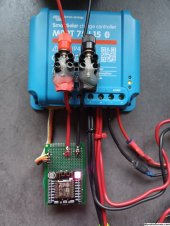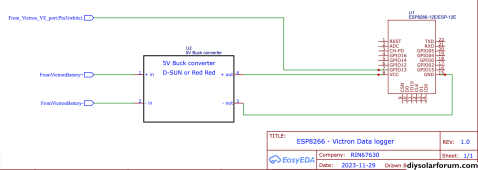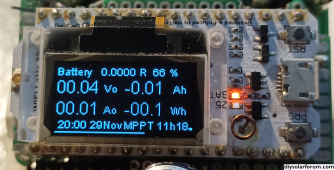rin67630
Solar Enthusiast
(Original old post replaced with something more representative of the current situation of my project)
I will maintain that first post current to give a first impression of the project at a glance.
My project Victron_VE_on_Steroids gets more and more functions.
It started an alternative logger for the Victron VE interface (MPPT Chargers and Smart Shunts)
It can now be configured as a very low-cost vendor agnostic Smarter Shunt as well

The Smart-Shunt requirements on hardware are extremely limited:
- a shunt (that you probably already have, any shunt up to 75mV can be configured)
- an ESP 8266 microcontroller (~4$) (Wemos-D1 recommended but others do as well)
- an INA226 off-rail power interface (~5$)
- a 8-35V to 5V micro buck converter. (~2$)
- a few wires and some prototype case
The Victron logger requirements are even lower:
- an ESP 8266 microcontroller (~4$) (Wemos-D1 recommended but others do as well)
- a 8-35V to 5V micro buck converter. (~2$)
- a few wires and some prototype case
Optionally
- a snap-on OLED shield 64x48 pixels for the Wemos D1 (~5$)
- or a 128*64 I2C OLED display (~5$) much better, needs a few more wires soldered.
Everything is self-contained. The communication occurs over WLAN and is completely wireless. (no ground loops to be feared).
No additional computer or gateway required for permanent operation !
What do you need to get started:
Above mentioned devices
A computer.
Free Software: the Arduino programming IDE.
An access to Github to download the code.
You don't need an extensive programming knowledge: the program adapts to your situation over a few directives on the config.h and credentials.h files.
here an example:
But, if you feel in the mood to get your hands in the guts: I write code like an engineer, not a programmer: close to natural language to remain understandable to everybody.
Once compiled and uploaded, from your computer, you can access the device over Telnet, e.g. :
Over Internet, using a permanently free account at thinger.io for up to two devices, you get a gorgeous dashboard to monitor your data.

And the project permanently evolves and gets new functions...
(I live in a condominium and cannot use a full blown solar installation, so the shown Voltage / Current values
in my examples are limited, but everything is scalable)
The regular version of the Smarter Shunt and Victron VE logger works with batteries up to 24V nominal.
I have an alternative hi-volt version available up to 48V too, but you need to find an adequate DC/DC converter able to handle up to 60V.
The software is completely free and open-source under creative common license CC BY-SA.
It is given in the hope to be useful, but I am NOT RESPONSIBLE IN ANY WAY OF DAMAGES WAHTSOEVER occuring from the use of my software.
The project is on GitHub.
Anybody wishing to join is welcome...
Please feel free to discuss at the end of that thread. Suggestions are welcome.
I also would love to get feed-back from people using other products with Victron-PE interface.
I will maintain that first post current to give a first impression of the project at a glance.
My project Victron_VE_on_Steroids gets more and more functions.
It started an alternative logger for the Victron VE interface (MPPT Chargers and Smart Shunts)
It can now be configured as a very low-cost vendor agnostic Smarter Shunt as well
The Smart-Shunt requirements on hardware are extremely limited:
- a shunt (that you probably already have, any shunt up to 75mV can be configured)
- an ESP 8266 microcontroller (~4$) (Wemos-D1 recommended but others do as well)
- an INA226 off-rail power interface (~5$)
- a 8-35V to 5V micro buck converter. (~2$)
- a few wires and some prototype case
The Victron logger requirements are even lower:
- an ESP 8266 microcontroller (~4$) (Wemos-D1 recommended but others do as well)
- a 8-35V to 5V micro buck converter. (~2$)
- a few wires and some prototype case
Optionally
- a snap-on OLED shield 64x48 pixels for the Wemos D1 (~5$)
- or a 128*64 I2C OLED display (~5$) much better, needs a few more wires soldered.
Everything is self-contained. The communication occurs over WLAN and is completely wireless. (no ground loops to be feared).
No additional computer or gateway required for permanent operation !
What do you need to get started:
Above mentioned devices
A computer.
Free Software: the Arduino programming IDE.
An access to Github to download the code.
You don't need an extensive programming knowledge: the program adapts to your situation over a few directives on the config.h and credentials.h files.
here an example:
Code:
//----------------------- HARDWARE OPTIONS ---------------------------------
#define AO_IS_NONE // _NONE , _DOUBLEBATTERY , _HALFBATTERY, _PANEL, _POT
#define A0_MAX 15 // if A0 is used, define the voltage of the full range measure
#define D0_IS_NONE // _NONE , _RELAY1
#define D5_IS_NONE // _NONE , _RELAY2
#define D6_IS_NONE // _NONE , _RELAY3, _VE_BLOCK, _VE_START_STOP
#define D7_IS_NONE // _NONE , _RELAY4; _VICTRON
#define OLED_IS_64x48 // _NONE , _64x48 , _128x64
#define OLED_IS_REVERSED // _IS_NORMAL, _IS_REVERSED To turn the display 180° if required
#define INA_IS_226 // _NONE , _226
#define INA_VBUS_IS_HALF // _FULL _HALF (when high voltage schematic is used)
//#include "MPPT_75_15.h"
#include "SHUNT_10A_75mV.h"
#include "LiFePo_13V_100Ah.h"
//----------------------- SOFTWARE OPTIONS ---------------------------------
#define WEATHER_IS_OWM // _NONE , _OWM , _BME680 // (Source of the Weather Information)
#define DASHBRD_IS_NONE // _NONE , _THINGER // (Internet Dashboard)
#define TERM_IS_TELNET // _NONE , _TELNET, _SERIAL , _SOFTSER // where do Menus and Reports occur: _SERIAL and D7_IS_VICTRON mutually exclusive )
#define UDP_IS_NONE // _NONE , _SEND , _RECEIVE // (UDP Inter-ESP Communication)
#define COM_IS_NONE // _NONE , _MIDNIGHT // Periodical reports to computer
#define ESP_UDP_ADDR "192.168.188.64" // (IP of the receiving ESP)
#define ESP_UDP_PORT 4200 // (Port used to send/receive Values to other ESP)
#define COM_UDP_ADDR "192.168.188.1" // (IP of the receiving computer for night reports)
#define COM_UDP_PORT 4200 // (Port used to send/receive Values to other computer)
#define DEVICE_NAME "ESP_LP" // Name of the device used as Hostname and at Thinger.io
#define DEVICE_NUMBER 0But, if you feel in the mood to get your hands in the guts: I write code like an engineer, not a programmer: close to natural language to remain understandable to everybody.
Once compiled and uploaded, from your computer, you can access the device over Telnet, e.g. :
Code:
$ telnet 192.168.188.27
Trying 192.168.188.27...
Connected to steroids.fritz.box.
Escape character is '^]'.
Waiting for input
B
Battery Stats
Hour | 00 | 01 | 02 | 03 | 04 | 05 | 06 | 07 | 08 | 09 | 10 | 11 |
Bat Ah | 12.63 | 00.00 | 00.00 | 00.00 | 00.00 | 00.00 | 00.00 | 00.00 | -0.00 | -0.02 | 00.01 | 00.06 |
Bat V | 12.46 | 12.45 | 12.43 | 12.43 | 12.43 | 12.42 | 12.42 | 12.41 | 12.41 | 12.43 | 12.45 | 12.61 |
Hour | 12 | 13 | 14 | 15 | 16 | 17 | 18 | 19 | 20 | 21 | 22 | 23 |
Bat Ah | 00.36 | 00.52 | 00.36 | 00.06 | 00.46 | 00.02 | 00.00 | 00.00 | 00.00 | 00.00 | 00.00 | 00.00 |
Bat V | 13.28 | 13.95 | 12.96 | 12.57 | 12.79 | 12.56 | 12.51 | 12.50 | 12.48 | 12.47 | 12.47 | 12.46 |
V
Values Report
BatV:12.56 BatI:-0.03 BatW: -0.38 PanV: 17.52 PanI: 00.00 PanW: 00.00 LoadI: 00.00 LoadW: 00.00 IOhm: 0.0008
BatV:12.56 BatI:-0.03 BatW: -0.38 PanV: 15.27 PanI: 00.00 PanW: 00.00 LoadI: 00.00 LoadW: 00.00 IOhm: 0.0008
BatV:12.56 BatI:-0.04 BatW: -0.50 PanV: 15.23 PanI: 00.00 PanW: 00.00 LoadI: 00.00 LoadW: 00.00 IOhm: 0.0008
BatV:12.56 BatI:-0.04 BatW: -0.50 PanV: 14.75 PanI: 00.00 PanW: 00.00 LoadI: 00.00 LoadW: 00.00 IOhm: 0.0008
BatV:12.56 BatI:-0.04 BatW: -0.50 PanV: 14.58 PanI: 00.00 PanW: 00.00 LoadI: 00.00 LoadW: 00.00 IOhm: 0.0008
BatV:12.56 BatI:-0.02 BatW: -0.25 PanV: 14.43 PanI: 00.00 PanW: 00.00 LoadI: 00.00 LoadW: 00.00 IOhm: 0.0008
Waiting for input
W
Weather list :
Temp: 8.9°C Hum: 80.0% Press: 1028mBAR WindSpeed: 8.8m/s Direction: 230°N Clouds: 100% Summary: overcast cloudsOver Internet, using a permanently free account at thinger.io for up to two devices, you get a gorgeous dashboard to monitor your data.
And the project permanently evolves and gets new functions...
(I live in a condominium and cannot use a full blown solar installation, so the shown Voltage / Current values
in my examples are limited, but everything is scalable)
The regular version of the Smarter Shunt and Victron VE logger works with batteries up to 24V nominal.
I have an alternative hi-volt version available up to 48V too, but you need to find an adequate DC/DC converter able to handle up to 60V.
The software is completely free and open-source under creative common license CC BY-SA.
It is given in the hope to be useful, but I am NOT RESPONSIBLE IN ANY WAY OF DAMAGES WAHTSOEVER occuring from the use of my software.
The project is on GitHub.
Anybody wishing to join is welcome...
Please feel free to discuss at the end of that thread. Suggestions are welcome.
I also would love to get feed-back from people using other products with Victron-PE interface.
Last edited:







